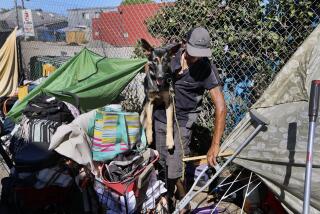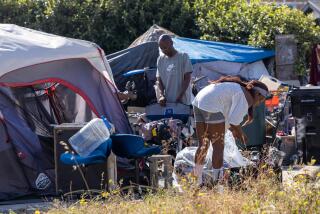CENSUS NOTEBOOK : Homeless Prove Hard to Find in Orange County
- Share via
Full of great expectations, John Inmon set out early Wednesday morning to count the homeless of Orange County. Trouble is, he discovered, you can’t count them if you can’t find them.
Outfitted in luminescent white vests, Inmon and two partners poked through parks in Tustin, probed railroad tracks stretching along the county’s southern flank, peered beneath bushes and pointed flashlights under freeway overpasses--all as part of the U.S. Census Bureau’s ambitious, nationwide effort to count the homeless.
But after more than two hours spent doggedly searching the usual spots where the homeless congregate, the census takers came up empty-handed.
It was, Inmon admitted, “sort of disappointing not to have found anyone.”
Some census officials said Wednesday that it appeared the homeless had been avoiding being counted.
“We went under bridges and overpasses and it just looked like those places had been cleaned out,” said Gene Glenn, Fullerton census field operations supervisor. “You could see signs that people had been living there, but it just seemed like they had picked up and left.”
Lisavette Barden checked underneath several freeway overpasses for the census effort and came away with a similar impression.
“It seemed like people split when they saw us,” she said. “We’d see their things still lying there, but they’d be gone.”
Fear certainly played into the formula, authorities said. Ken Hulett, a field researcher for the Fullerton census office, said he cast his flashlight beam on two homeless people under a freeway bridge and drew an unmistakable response.
“At first they raised their hands,” he said. “I guess they thought we were cops.”
Stu Wakley, 38, was standing in front of the YMCA in Santa Ana, talking with some of his buddies from the streets while the census was being conducted. Wakley has been homeless for almost two years. His life began unraveling when he was injured during a construction job two years ago.Now he spends most nights in deserted parks throughout the county.
“I think counting the homeless in the census is important so the government will know where the problems are,” Wakley said. “That way, they can work on building affordable housing.”
Johnny Solorio, a 39-year-old homeless man in Santa Ana, also held out hope that the census might mean a change for the better.
“Maybe if they know how many people are out here, maybe they can help get us all jobs,” said Solorio, a bearded, 6-foot-3 man with a barrel chest. “It might be a positive wave to come through.”
But for Solorio, it wasn’t what one would call a good night.
Taking swigs out of a bottle of liquor, Solorio began using a golf club to fence with a companion wielding a baseball bat. Games became serious when Solorio swung wildly and hit the other man in the face, gashing his forehead.
As blood gushed from the wound, a crowd of other homeless men gathered around and berated Solorio.
After a few minutes of desperately attempting to apologize, Solorio gave up and left, promising never to return to the street corner.
Many of the homeless are “professional hiders,” people who have learned that survival on the street means sinking out of sight when darkness falls, said Emily Lietz, census director in Buena Park. And the census count may have suffered because of it.
Every morning since she opened the Buena Park office in October, Lietz has seen a homeless man appear as if out of nowhere on a bench outside her window. That is, except on the day of the census.
At one point, Lietz resorted to sending out an employee to look for the man, but “we couldn’t find him in the night,” she said. He only reappeared after the sun came up Wednesday when the counting was over.
Joe Montes, director of the Fullerton census office, spent three hours searching the streets with a survey crew. They returned without finding evidence of a single homeless person.
As other field enumerators began trickling in, it became obvious that most others had experienced no better luck. The next three teams said they turned up no one on their searches. A fourth team’s announcement that a homeless man had been found under an overpass elicited cheers from tired workers.
By 6:30 a.m. Wednesday, two more teams had checked in with a total of 13 more homeless found under bridges, overpasses or sleeping in vehicles in mall parking lots.
“This is awfully discouraging,” said Lou Porchia, Fullerton field operation manager. “How can we count these people if they don’t stand up? If they’re not there, you can’t count them.”
As the most ambitious effort of its type ever, the homeless census had its glitches.
At the Anaheim Interfaith Shelter, a 10-unit complex, three sets of census takers rolled by during the night, according to Chaundra Perry-Howard, 26, who has lived in the 10-unit complex since she separated from her husband.
Perry-Howard said the census process was a breeze. “They just asked a couple of questions, filled out the form, and I guess now I’m counted. . . . Homeless is not just bums in the park, it’s also being too proud to go home to Mom and Dad.”
Dan Cantor, night supervisor at Laguna Beach’s 24-bed Friendship Shelter, said he was surprised by the arrival of the census takers Tuesday night.
“I had heard about the census, but no one warned us they were coming,” Cantor said. “Two people just arrived here about 9 p.m.”
Cantor rounded up most of the shelter’s occupants, who gathered in a meeting room at the back of the two-story structure that once had been an apartment house.
“We had some people at the Laundromat, a few others were just out,” Cantor said. “Judging by this, I can’t say they got an accurate count. I don’t think most of my clients knew about it. They really don’t read the papers.”
David Mahoney, a Westminster resident who helped out as a census taker, said he had expected the homeless “to know what’s going on” with the census, but most “had no idea what we were talking about. I thought there would be a little more reception because of TV ads. But I guess that doesn’t matter since they don’t have a TV.”
Not everyone subsisting on the streets was so out of touch with the plans of the U.S. Census Bureau. Numerous homeless people were able to recite all the reasons for the survey--to gauge the nation’s population, to determine how federal monies should be distributed. And some suggested it might benefit their lives if they participated.
“It’s a great idea because if they are going to allocate money for the homeless and they need to know what’s out there,” said Anthony Wallace, a 27-year-old homeless man. “They are going to be surprised by the figure.”
By dawn Wednesday, Kenneth Nash and his team of enumerators in North Orange County had counted just one homeless person as they shuttled to various parks and business districts.
As the first rays of sunlight embraced the landscape, the census takers saw a man in a car stir and sit up. They recorded his race and approximate age, but did not bother disturbing him further.
Later they found another man sleeping in a nook of a railroad bridge and several empty sleeping bags. They returned to the office after finding just three homeless people.
“I’m disappointed we didn’t see them,” Nash said. “I know they’re out there. . . . We’ll have to do something different next time. I don’t know what.”
Contributing to this story were Times staff writer Carla Rivera and correspondents Len Hall, Greg Hernandez, Tom McQueeney, Laura Michaelis, Michelle Nicolosi, John Penner and Leon Teeboom.
More to Read
Sign up for Essential California
The most important California stories and recommendations in your inbox every morning.
You may occasionally receive promotional content from the Los Angeles Times.









